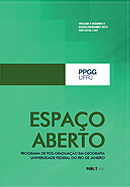Fundamentals of Ethnopedogeomorphology: Anchors for a New Discipline of Physical Geography
DOI:
https://doi.org/10.36403/espacoaberto.2024.63461Keywords:
Ethnoscience, Ethnopedogeomorphology, Rural Landscape, Traditional Communities, Geography TeachingAbstract
The first decades of the 21st century witnessed the emergence of new ways of articulating classical scientific knowledge with vernacular practices guided by the emergence or resumption of ethnoscientific approaches. These disciplines are essential to understanding the connections created by traditional rural populations and their relationship with the soil, landforms, and land use. New ways of contextualizing the geographical space emerged based on the perceptions of physical-natural environments by traditional communities. In this context, ethnopedogeomorphology emerges as a system of knowledge that is sister to ethnoecology and ethnopedology. A literature review of the state-of-the-art conceptual discussion that defines the scope of ethnopedogeomorphology was carried out, as a possible new thematic area of physical geography. Its applications range from the development of classifications and taxonomies aimed at understanding the relationship between soil and landforms to an instrument for teaching physical geography on a phenomenological basis within traditional communities.
Metrics
Downloads
Published
How to Cite
Issue
Section
License
Copyright (c) 2024 Paulo Lucas Cândido de Farias, Antonio Carlos de Barros Corrêa, Simone Cardoso Ribeiro

This work is licensed under a Creative Commons Attribution-NonCommercial-ShareAlike 4.0 International License.


